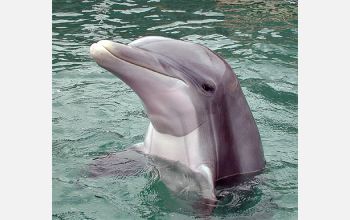Multimedia Gallery
Boris the Atlantic bottlenose dolphin
Boris is an Atlantic bottlenose dolphin at the Hawaii Institute of Marine Biology, part of the University of Hawaii.
More about this Image
Boris is a 13-year-old Atlantic bottlenose dolphin who was born in a breeding colony at the Hawaii Institute of Marine Biology. Most of the studies involving Boris focus on hearing. Dolphins and whales rely on their acoustic senses for locating prey and for communication with their species. Scientists are concerned about how noise projected into the water from super tankers, oil exploration, navy sonar and oceanographic experiments may effect their acoustic capabilities and think it's important to test the hearing of as many species as possible.
Boris is trained to swim into a hoop and wait for a tone. If he hears the tone he will swim up and press a small ball. If he doesn't hear a tone, he will remain in his hoop until he hears a whistle telling him that he is correct--no tone was presented. The tones played will gradually become quieter and quieter until his "threshold" is met, thus determining how well he hears.
Boris also participates in a hearing test in which he wears small, gold-plated, disk-shaped human EEG sensors that are held on the surface of his skin by soft, rubber suction cups. One sensor is placed on the skin on his head over his large brain. The other sensor is placed back by his dorsal fin for a reference. Once Boris is comfortably wearing the sensors, he will swim under water and sit still in a hoop. A researcher will play sounds with patterns and when Boris hears a sound, his brain wave patterns follow the patterns of the sound presented. This test is much quicker than the test involving the ball because all Boris has to do is sit still and listen. This new testing procedure was developed with the help of visiting professor Alexander Supin from the Russian Academy of Sciences. Professor Supin was a guest researcher on a grant that was supported in part by the National Science Foundation (NSF), that brought Russian scientists to the United States temporarily.
Researchers at the institute believe that this new testing procedure will eventually be expanded to allow for the testing of many of the larger species of whales. There are over 85 species of whales and dolphins but researchers at the institute have only measured the hearing of 10.
NSF supports certain aspects of this ongoing research with marine animals at the institute. Further information about the institute is available on their website Here. (Year of image: 2001)
Credit: Karen Pearce, National Science Foundation
Images and other media in the National Science Foundation Multimedia Gallery are available for use in print and electronic material by NSF employees, members of the media, university staff, teachers and the general public. All media in the gallery are intended for personal, educational and nonprofit/non-commercial use only.
Images credited to the National Science Foundation, a federal agency, are in the public domain. The images were created by employees of the United States Government as part of their official duties or prepared by contractors as "works for hire" for NSF. You may freely use NSF-credited images and, at your discretion, credit NSF with a "Courtesy: National Science Foundation" notation.
Additional information about general usage can be found in Conditions.
Also Available:
Download the high-resolution JPG version of the image. (205 KB)
Use your mouse to right-click (Mac users may need to Ctrl-click) the link above and choose the option that will save the file or target to your computer.



 All images in this series
All images in this series